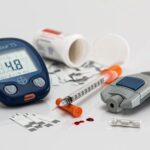 Almost ¼ million Irish people have diabetes, and a further ½ million of us are pre-diabetic. This is particularly shocking when you consider that most cases are preventable and that it can have serious long-term health consequences. It’s not all bad news though! There are some easy ways to identify if you are at risk and some simple dietary changes that can reduce your risk in as little as three months. Read on or watch Glenville Nutrition share her tips on Virgin Media’s Weekend AM.
Almost ¼ million Irish people have diabetes, and a further ½ million of us are pre-diabetic. This is particularly shocking when you consider that most cases are preventable and that it can have serious long-term health consequences. It’s not all bad news though! There are some easy ways to identify if you are at risk and some simple dietary changes that can reduce your risk in as little as three months. Read on or watch Glenville Nutrition share her tips on Virgin Media’s Weekend AM.
Are you at risk of diabetes?
It’s important to bear a couple of things in mind. Firstly, we are not covering type 1 diabetes, a much rarer auto immune condition with very different risk factors (10 – 15% of diabetics). We are focusing on type 2 diabetes, because 1 in 5 Irish people have a family member with type 2 diabetes. Secondly, if you are suffering from certain symptoms including persistent thirst, a need to go to the toilet frequently or are feeling very tired, you should go to your GP to rule out diabetes. It is estimated that there are around 30,000 people in Ireland with un-diagnosed diabetes today.
Pre-diabetes is a much more common issue than full blown diabetes. It occurs when blood sugar starts rising, indicating that the amount of insulin you are producing is not able to manage the levels of sugar in your blood. If not acted upon, this can lead to diabetes.
Clues you may be pre-diabetic
Prediabetes, especially in the early stages, does not have any real symptoms. However, there are 3 signs that you might be at risk:
- Family history (parents, siblings) of type 2 diabetes, or having gestational diabetes yourself
- Carrying too much weight or a raised BMI (20 – 25 is the ideal range)
- Carrying weight around the middle. This is a real giveaway, even if your BMI is normal and especially if you are slim elsewhere but find you are gaining weight around the middle
Check yourself at home
An easy way to check if you are carrying too much weight around your middle is to check your waist: height ratio. Check your waist measurement, measuring just above your belly button (NB men usually measure around the waist band of their trousers, which is too low). This should be less than half of your height. e.g. if you are 5’6’’ (= 66 inches), your waistline should be less than 33 inches.
Three steps to reducing your risk of diabetes
If you do have any of these risk factors, there are 3 steps to reduce your risk or reduce your blood sugar and insulin levels if these are already raised
-
Reduce your sugar intake
It’s an obvious one, but the link between sugar and type 2 diabetes is very clear. The more sugar you eat, the harder your body has to work to keep your blood sugar level in range. Eventually your capacity to deal with the excess sugar will run out, leading to insulin resistance (pre-diabetes) and then diabetes.
Avoid soft drinks and try to limit your treats e.g. to weekends. This is just as if not more important for kids as for adults. If you are used to lots of treats from an early age, then you will find it a difficult habit to break. During Covid, many of us are eating more treats and with Christmas just around the corner I appreciate this is not an easy message, but it is important.
Beyond treats, watch where sugar might be sneaking into your diet. Two food groups worth mentioning are yoghurts and cereals. Some yoghurts we looked at had 7 or more teaspoons of sugar, more than a chocolate bar and more than the daily added sugar limit for women. Ideally avoid fruit yoghurt or other flavoured yoghurts like vanilla. Go for natural yoghurt and sweeten with fruit or jam yourself. Have a look at the ingredient list of the yoghurts, cereals, and other foods you buy every week. If sugar or a form of sugar, especially glucose-fructose syrup is listed in the first 5 ingredients, avoid it.
-
Chose wholegrains and limit portion size
White bread and other refined carbs like white rice and white pasta are staples for many of us. However, because their fibre has been removed, these foods act like sugar in our body. They convert to energy very quickly and cause a fast rise in blood sugar levels, detectable in even a few minutes. Whole grain foods take longer to break down, causing a more gradual increase. For bread, look for 100% wholegrain or wholemeal bread on the label. Granary-type bread is often just white bread with brown colouring and seeds added to make it appear healthier.
Bear in mind, is not just the type of carbs we chose, it’s also the quantity. Too much, even of the slow releasing carbs, will cause our blood sugar and insulin levels to rise and our weight and waistline along with them. Have a look at the portion size information on the packaging of the carbs like rice and pasta you buy and limit your carbs to ¼ of your plate. A healthy plate at lunch and dinner should be ¼ carbs, ¼ protein and ½ veg and you can adapt your regular meals to fit this. For example, if you are making spaghetti Bolognese, you can include more veg in the Bolognese, serve it with a side salad and have just a small portion of wholegrain pasta.
-
Avoid grazing all day – give your body a break
Many of us, particularly now, are in the habit of snacking throughout the day, even if we are not hungry. We don’t recommend going for longer than 4 hours without eating during the day, 3 meals and 1 healthy snack for most of us. But grazing all day means that our insulin levels never fall, keeping us in constant storage mode and contributing to insulin resistance.
While more dramatic forms of intermittent fasting can be dangerous, the evidence for fasting overnight for 12 hours as a way of reducing your risk of diabetes is extremely promising. Aim to finish your dinner by 7 or 8pm and then fast for 12 hours overnight. This helps to reduce your risk of type 2 diabetes by helping your insulin levels to fall, allowing your cells to burn fat. It also cuts out the very tempting treats that we can find ourselves munching on in front of the TV. Stick to your 3 balanced meals, have a healthy snack like a piece of fruit and palmful of nuts in your longest gap and finish eating by 7 or 8pm.
Follow the 80:20 rule
We usually recommend following the 80:20 rule, so even sticking to these recommendations Monday to Friday will make a big difference and you should see the benefit in less than 3 months. If you have been told that you are already pre-diabetic, you might want to be a bit stricter and just give yourself one night off or stick to the plan until your blood markers have improved.
Sample menu
| Breakfast | Small portion of porridge with 1 tbsp toasted flaked almonds cinnamon, chopped apple or berries |
| Lunch | Warming sweet potato soup, slice of wholegrain bread |
| Snack | Easy banana pancakes (great for school lunchboxes) |
| Dinner | Salmon burgers with salad and portion wholegrain rice / potato |
If you would like more information about the services we offer, including testing, please get in touch.

